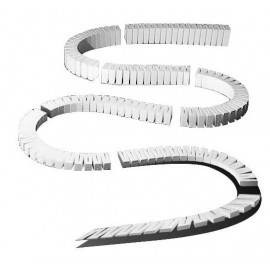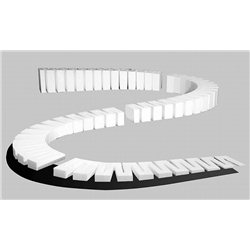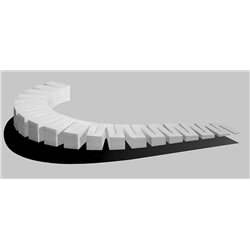There are a number of different options for attaching figures such as a horse and rider to a layout. Perhaps the...
No products
Product successfully added to your shopping cart
There are 0 items in your cart. There is 1 item in your cart.
Search Tips
What are the Woodland Scenics incline?
Woodland Scenics inclines are pre-moulded foam products designed to help model railway modellers create realistic gradients on their layouts without needing complex calculations or the tedious shaping of materials. These inclines offer a simple way to add elevation changes that make layouts more engaging and dynamic. Available in various angles and sizes, Woodland Scenics inclines are particularly popular among modellers because they simplify the process of building smooth, consistent slopes.
In a model railway, inclines add interest and realism by mimicking the natural undulations you’d see on real railways. Woodland Scenics offers incline sets in several gradient options, most commonly 2%, 3% and 4%. The 2% gradient is often a good choice for smaller scales like N gauge, where a more gradual slope is required to prevent derailments due to sharp changes in elevation. In OO gauge, where the locomotives and rolling stock are larger and heavier, a 3% incline can work well for layouts with slightly more room, creating a moderate hill without requiring extensive space.
These inclines are especially useful for beginners, as they eliminate the need to measure and cut foam or wood for smooth transitions between levels. Each incline set includes pre-formed pieces that align together seamlessly, allowing for quick installation. For instance, if you're working in OO gauge and want a long, sweeping incline, the 2% or 3% grades are ideal. They provide enough of a slope to look realistic without causing issues for standard OO gauge locomotives, which typically struggle on inclines steeper than 4%.
One popular setup is using Woodland Scenics inclines to create overpasses or bridge approaches. In N gauge, which is smaller and more compact, the 2% incline is often used for bridge approaches, ensuring that trains have enough power to ascend without issues. For example, a modeller might install a 2% incline over 4 feet to gently raise the track to cross over another line. In OO gauge, the 3% incline can add dramatic height changes, giving you more room for tunnels or overpasses and creating visually impressive features that make the layout stand out.
An added benefit of Woodland Scenics inclines is their compatibility with other Woodland Scenics foam products. These include risers, which you can use to elevate sections of track at a consistent height before beginning the incline. This flexibility is helpful if you’re planning a layout with both raised and lowered areas, as it provides a smooth transition between different heights. For instance, on a multi-level OO gauge layout, you might use 3% inclines combined with 1" risers to create an elevated line running parallel to a mainline on the lower level.
The ease of shaping and cutting Woodland Scenics foam makes it easy to adapt the inclines for complex layouts. You can trim them to fit curves or junctions, allowing you to create custom paths that match the track plan. In N gauge layouts, where space is at a premium, the ability to fit an incline neatly into a tight corner or under a bridge is invaluable. In OO gauge, with a bit more room, you can use these inclines to add winding hillsides or dramatic passes through valleys, transforming a flat layout into a scenic masterpiece.
Ultimately, Woodland Scenics inclines provide a versatile and user-friendly solution for adding elevation to your railway, making it accessible for both beginners and advanced modellers alike. They’re especially advantageous in N and OO gauge layouts, where the balance of realism and functionality is crucial for a satisfying layout. So whether you’re looking to create a rolling countryside in OO gauge or a compact, mountainous N gauge scene, these inclines offer the consistency and reliability needed to make your railway run smoothly on any gradient.
Click here to receive the tips weekly in your mailbox. You can unsubscribe at any time.










